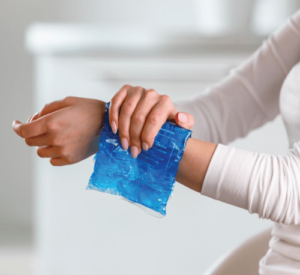
Treating Back Injury After Car Accident or Fall Trauma
A study published in Pain Magazine found that patients who saw chiropractors after a back injury or fall were over 60% less likely to fill an opioid prescription.

When it comes to relieving pain at home, our patients have a lot of questions. Should I use heat, or should I use ice for pain? Does one work better than the other? Can I use cold therapy and heat therapy together?
The short answer: Both. Sometimes. Yes.
The full story? Well, read on and we’ll tell you when – and how – to use each one to help relieve pain and aid recovery, and help get you moving again.

When it comes to using cold therapy for pain, there’s a simple general rule. Choose ice for pain when you have an acute (recent) injury, and/or inflammation (redness and swelling) is present.
Ice helps with acute injury pain and inflammation by restricting blood flow. Injuries like sprains, strains, and bruising all cause bleeding in your underlying tissue. Ice reduces blood flow to the area, slowing that bleeding, reducing swelling and pain. This can also reduce stiffness (caused by swelling.)
Icing an injury as soon as it happens can relieve pain, help prevent long-term swelling and potentially reduce your recovery time. Here’s how to do it:
Cold therapy is used for both acute injuries (from the time of the incident to about 4 day post injury) and rehabilitating injuries: helping you move from the post-acute stage all the way to recovery.
When using cold therapy for an injury, follow the 20-20 rule: ice the injury for 20 minutes (no longer) with 20-minute breaks in between sessions. Ice can be used long term. For example, some athletes will ice an area that has previously sustained an injury before playing/competing to help prevent potential soreness or swelling.
While we typically think of icing an injury as simply applying an ice pack (or a bag of frozen veggies – we love that option), there are multiple ways to employ cold therapy. Different types of cold therapy can be ideal for different types of pain, including:
Ice or cold therapy are recommended for:
If you have poor circulation, then cold therapy probably is not the best choice for you. Applying ice for too long, or applying it or directly to the skin can result in tissue or nerve damage, and the risk is higher in individuals with poor circulation. If you have cardiovascular disease always consult with their doctor before using cold therapy.

Unlike cold therapy, which is typically used only for injuries, heat therapy has a multitude of uses – including relaxation (there’s a reason we start our day with a cold plunge and end it with a hot shower, bath, or spa soak.) Heat loosens tight muscles and helps in reducing muscle spasms. It can also reduce the perception of pain signals.
Heat therapy opens the blood vessels, increasing blood flow. When applied to a specific, singular area, you can direct increased flow to just that area – for example, relaxing the upper back or the muscles of the back of the neck to help relieve a tension headache.
When blood flow is increased, so is the delivery of oxygen and nutrients to the injured tissue, which helps to stimulate healing and repair damaged tissue.
Minor stiffness and tension can usually be relieved with about 15-20 minutes of heat therapy.
Moist Heat vs. Dry Heat
Unlike cold therapy, heat therapy can be applied two ways: moist or dry. Many healthcare professionals consider moist heat to be more effective than dry heat, as it appears to penetrate the muscles more effectively. A wet washcloth used in combination with a heating pad, warm damp towels, or a warm bath or shower are all great ways to apply moist heat to soothe pain.
When it comes to dry heat, heating pads, heated gel packs, hot water bottles, and heat wraps are easy to keep on hand and a quick and effective way to put heat therapy to work. Apply the heat directly to the affected area.
How Long Should You Apply Heat Therapy?
How long to apply heat therapy depends on your comfort level and the type of heat therapy you’re using. Just like cold therapy, the generally accepted rule is to apple heat for no more than 20 minutes at a time. Be sure to let your skin cool down and blood flow recede between therapy sessions (usually a break of at least one hour is recommended.) Heat therapy can be repeated several times a day.
Heat Therapy is recommended for:
Stiff or sore? Heat therapy can help. Dealing with swelling or bruising? Skip the heat and reach for the ice. When using heat therapy, maintain even warmth to the affected area. Never use heat therapy on an open wound (or cold therapy for that matter), and if you’re living with heart disease or hypertension, be sure to ask your doctor before using heat therapy.
So, should you use ice or heat for pain? Both have correct applications but neither heat nor ice are long-term solutions for pain. If you’re living with recurring musculoskeletal pain – back pain, neck pain, joint pain, headaches, carpal tunnel syndrome, jaw pain – chiropractic care may be able to help you find lasting relief by treating your pain at the source. Regular chiropractic care can help support and return the body to a normal state, reducing tension and pain by utilizing the body’s natural healing process to speed up your recovery time, if an injury happens.
Ready for relief? Find the Chiro One clinic nearest to you.
Subscribe and get news, articles & offers sent right to your inbox each month.
"*" indicates required fields
By subscribing you are agreeing to the Terms and Conditions and Privacy Policy.